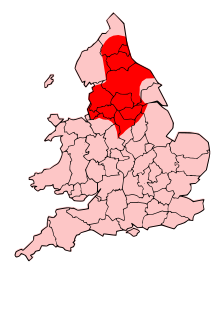Brigantes
![]()
This article is about the Celtic ethnic group; for the pirates and brigands, see Brigand.
Brigantes, in Latin and in Breton Brigantes, is the name given to a loose association of Celtic tribes, or rather ethnic groups, in northeastern Britain. They settled near Eboracum (today York), roughly speaking in the area between the rivers Humber and Tyne. Their capital, or rather administrative centre, became Isurium Brigantum, now Aldborough, after the Roman conquest. They are said to have spoken a language related to Welsh.
They differed from their Celtic relatives living further south, as evidenced by archaeological finds, by having a more rustic, peasant culture. They are loosely related to the Brigantier tribe. The Brigantier, Latin Brigantii, settled in central Raetia on Lake Constance ("Brigantinus Lacus") in the area of present-day Austrian Vorarlberg. Whether the Brigantians had moved from Raetia to Britain or, conversely, the English Brigantes to the mainland cannot be clearly established by sources. However, both groups are said to have worshipped a certain Brigid, Latin Brigantia, as their central deity.
All information about the Brigantes that goes beyond the archaeological findings must be treated with caution, since it is based almost exclusively on descriptions by Roman historians, especially Tacitus. It is not even possible to prove whether the Brigantes called themselves this or something similar, since the Romans had a tendency to call everything unknown to them by Latinized names. This is especially true of the eponymous mother goddess Brigid or Brigantia, whose cult cannot be historically clarified beyond doubt. Brica or Briga is said to have meant "settlement by the water" in the linguistic usage of Celtic ethnic groups settling in the area of later Gaul and Germania, as linguists have been able to establish by derivation. A written culture of the Brigantes has not been handed down.
The term also appears without Celtic reference in the Romance-speaking world as a synonym for "stray", "homeless" or "beggar" (French brigand) and also as robber, bandit or rebel (brigant from Italian brigare, to fight, quarrel).

Approximate settlement area of the Brigantes
History
Before the Roman invasion, the Brigantes were the predominant ethnic group in what is now northeast England, though not an indigenous population in the area: these had presumably been Picts (pre-Indo-European, according to some), later named by the Romans because of their body paint, who had been pushed north by the Brigantes.
The Brigantes were defeated by the troops of Emperor Claudius in 43 AD, but their territory was initially not occupied and incorporated into the Roman province of Britannia: Unlike other Celtic tribes on the island, and especially the Picts, the Brigantes sought political settlement with Rome as an ally early on, so as not to endanger their own supremacy; at least that is how Tacitus reports it. The princess Cartimandua, who cleverly knew how to exploit rivalries within the various groups of the Brigantes and other ethnic groups associated with them, was particularly outstanding: according to Tacitus, in the year 51 she used a trick to lure the Welsh Celtic general Caratacus, who was leading the fight against the Romans, into a trap and delivered him to the Romans. This secured her the esteem of the Roman provincial governor Publius Ostorius Scapula, who repeatedly came to the aid of Cartimandua, a controversial figure within the Brigantes' Federation, with troops.
Only after Cartimandua's disempowerment around 70, when the revolts of individual brigand leaders increased, did Emperor Vespasian end the special status of the brigand federation, which consisted of nine power centers, and had the governor Gnaeus Iulius Agricola finally incorporate the area into the Roman province of Britannia in 79. During this time Isurium Brigantum emerged as the administrative center. The old forts of the Brigant Federation were razed.
In the course of the 2nd century, there were repeated Brigantes uprisings, which were, however, always put down by the Romans, as indicated by Roman coin finds from this period. The Greek geographer Pausanias reports of the suppression and expulsion of the Brigantes, especially under Emperor Antoninus Pius. The confederation was finally broken up and individual tribes or groups were forcibly resettled or expelled. During this period, some groups of Brigantes are said to have fled to Ireland, as suggested by an entry on a map by the Hellenic geographer and cartologist Ptolemy. Excavations on Lambay Island in southeastern Ireland, which have unearthed artifacts attributable to the Brigantes culture dating to the late 2nd century, seem to confirm this thesis.
As the Romans gradually withdrew from Britain by 410, the Picts, who were never fully pushed back, repeatedly invaded the Brigantes' tribal territory around 409, but were repelled with the help of the Saxons. Later, as Saxons and other Germanic tribes subdued Britain, many Brigantes retreated northward. The kingdom of Strathclyde is said to date back to them.
See also
- History of Britain
- List of Celtic tribes
Search within the encyclopedia